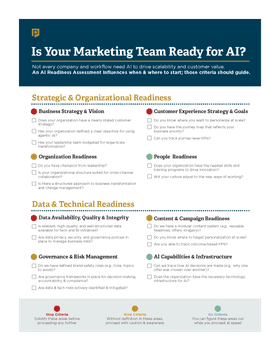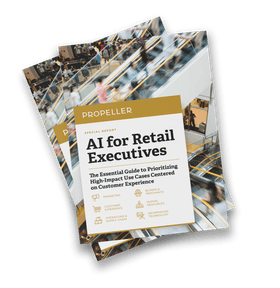Here's the paradox every marketing team knows: We can predict customer behavior, yet delivering hyper-personalized experiences still requires an army of coordinators, campaign managers, and channel specialists.
Today’s consumers expect hyper-relevant experiences across every touchpoint. Static, rule-based personalization — like showing “top 10 most popular” products or segment-specific offers — is no longer enough.
Despite widespread investment in personalization technology, 63% of digital marketing leaders still struggle with delivering hyper-personalized experiences. The problem isn’t a lack of data or insights, but operational bottlenecks that prevent marketers from translating insights into scalable personalization. Most brands have reached what we call the personalization efficiency wall.
A solution is emerging that addresses this coordination gap. Agentic AI doesn’t just predict what customers might do — it acts on that insight in real time with minimal human interaction, enabling a conversation between the customer and the brand. By analyzing context, intent, and behavior in real time, and autonomously acting on that data, Agentic AI can deliver scalable personalization that adapts and optimizes without human intervention.
# Predictive AI: Where Most Savvy Marketers Are Now
Predictive AI has become a familiar tool for marketers to use historical and contextual data to forecast customer behavior, powering product recommendations, lead scoring, and email timing optimization.
“At my client I’m seeing firsthand how predictive models can drive impressive incremental revenue, but I’ve also observed opportunities to scale operations. Teams are still manually coordinating actions that could easily be automated. That’s where agentic AI comes in—it’s the missing layer between great insights and scalable execution.”

Predictive AI delivers the insight, but scaling it across touchpoints, channels, and journeys still requires significant manual coordination.
# Agentic AI: The Next Level in Personalization Evolution
Agentic AI represents a shift from coordinated to autonomous personalization. These systems analyze real-time behaviors, preferences, and context to anticipate what each customer needs, often before the customer realizes it. They process data, make decisions, and deliver personalized experiences across channels with minimal human oversight, learning with every interaction to inform future decisions.
Think of it as the difference between a good forecast and a system that not only predicts rain but also adjusts your sprinklers, reminds you to carry an umbrella, and reschedules outdoor plans automatically.
# What Makes Agentic AI Different
- Reads the full context: Customer behavior, preferences, environmental factors (time, location, device), real-time intent signals, and open-ended inputs.
- Makes autonomous decisions: What message to show, which channel to use, when to deliver it, and what action comes next for each person’s tailored journey.
- Continuously optimizes: Automatically tests content, design, and timing in real time, shrinking testing cycles from weeks to hours.
This creates a closed-loop personalization engine that keeps improving with each interaction. The result is personalization that feels like a conversation.
# Agentic AI in Practice
Here’s how agentic AI transforms a real-world shopping experience. Let’s say a customer is shopping for a lightweight tent under $300 for a fall trip in Colorado.
Traditional predictive approach:
Shows relevant tents based on search terms and browsing history and sends a follow-up email in a few days.
With agentic AI, the experience can look like this:
- Smart Discovery: Search understands “lightweight tent for fall”. It applies local context (e.g., weather, season, inventory availability) and provides a recommendation for a tent that is waterproof and prioritizes waterproof options in stock for that region.
- Autonomous Next Best Action: It detects indecision and automatically triggers a chatbot offering a product comparison. It recommends accessories based on past purchases, predicted future purchases, and provides behavior-based context.
- Self-Built Content: The experience is tailored on the fly with images, copy, and layout adjusted based on the user’s location, journey stage, and preferences. No manual tagging, resizing, or localization required.
- Super Chat: A virtual concierge guides the user to the right tent, teeing up a promo offer with ideal timing.
How brands are applying it today
Brands like Starbucks are already combining context, behavior, and preference to personalize touchpoints, recommending drinks based on time of day and weather. Agentic AI builds on this by autonomously connecting these experiences across systems and optimizing them in real time.
Want more AI-powered retail use cases? Get our AI in Retail Use Case Guide for examples across marketing, operations, and CX.
# Evolving Your Teams for Agentic AI-Driven Personalization
The shift from rule-based or predictive AI to agentic personalization changes how creative, tech, and data teams work. The best-performing brands blend human strategy with machine execution.
“Some clients see peers putting AI into practice and feel the pressure to keep up but aren’t sure how to begin. For one client, we facilitated conversations between their AI leaders and less mature teams in the content lifecycle. This surfaced impactful use cases and openly addressed risks, giving clarity on what to move forward right away and where to spend more time strategizing.”
# Human + AI Collaboration Across the Content Lifecycle
Here are some examples of how AI can support teams across the personalization process:
- Creative Brief:
- Human: Set goals and provide direction
- AI Agents: Draft briefs, research market trends, and provide in-the-moment analysis
- Segmentation
- Human: Validate AI segmentations for fairness, KPIs, and business fit
- AI Agents: Standardize, cluster, and tag data; predict churn and value in real time; provide real-time first-party data activation
- Content Development
- Human: Provide creative direction, brand guidelines, and compliance for the variations
- AI Agents: Auto-generate copy and creative, translate, and produce A/B/n variants
- Asset Management
- Human: Approve assets and enforce governance
- AI Agents: Tag, store, and version-control assets; flag reusable content
- Content Management
- Human: Set messaging goals and review performance
- AI Agents: Match content to segments, localize dynamically, optimize in real time
- Orchestration
- Human: Design journey maps and cross-channel coordination
- AI Agents: Choose best channel/time, automate next action(s), and fine-tune with feedback
The key is to define where AI executes and where humans intervene, establishing strategy and guardrails. That balance is what makes agentic AI both scalable and brand safe.


# Organizational Challenges to Adopting Agentic AI
Moving to autonomous personalization requires more than just flipping a technology switch. The barriers are organizational as much as technical:
Cross-functional alignment on key metrics. Teams across channels must work toward shared, customer-led strategy goals rather than siloed KPIs.
Governance and safeguards. Organizations need to balance brand priorities with customer preferences while ensuring fairness, control, and transparency.
Data Readiness. Success depends on centralized, high-quality, behavior-rich data that flows seamlessly between systems.
New roles and skills. Because agentic AI touches marketing, tech, product, CX, and analytics, new hybrid roles like AI performance analysts are emerging.
Change management and enablement: Teams require significant training to adapt to new workflows and responsibilities.
# Your First Steps Toward Agentic AI Personalization
The path forward doesn’t require rebuilding everything at once. Most successful implementations start with a single decision point and expand. Here’s how teams can begin:
- Clarify objectives and metrics. Define what success looks like, whether it's conversion, retention, or loyalty, and establish measurable KPIS from the start.
- Map the customer journey. Outline all possible paths customers take, making sure they reflect both business priorities and your desired customer experience strategy.
- Establish governance frameworks. Create clear rules for AI decision-making and define where human oversight is required to ensure safety and brand alignment.
- Define human vs. AI ownership. Determine which tasks require human strategy and which can be delegated to AI agents. See our blog AI as Teammate for more details.
- Reconcile processes. Evaluate your end-to-end workflows and decide which truly benefit from agentic AI, and which are better left as is. Not every process needs to use agentic AI.
- Audit data and technology readiness. Assess the quality of your data, your infrastructure, and your content systems to identify and address critical gaps.
- Start small, scale fast. Pilot one or two decision points (e.g., recommendations or A/B testing), prove the ROI, and expand. Tools like our AI ROI calculator can help measure early results.
- Maintain your predictive AI foundation. Continue strengthening predictive models — they remain an important building block even as agentic capabilities mature.
Many of our clients begin with a narrow use case — such as automating content recommendations — and then scale gradually to cover entire customer journeys.
From Reactive to Autonomous Personalization
# Why Agentic AI is the Future of Personalization
We’ve moved past one-size-fits-all marketing. Agentic AI unlocks truly autonomous personalization, powered by real-time customer data and optimized through continuous learning.
The organizations that prepare now will deliver personalized experiences at a scale and sophistication that competitors can't match manually. They'll shrink testing cycles from weeks to hours, optimize across touchpoints without human coordination, and create customer experiences that feel genuinely conversational.
Preparation also means being selective — as we share in Don’t Go Full Autonomy Yet: How to Prioritize Agentic AI Use Cases That Scale, prioritizing scalable use cases prevents wasted investment and builds momentum for broader adoption.
At Propeller, we help clients build the foundation, frameworks, and workflows for intelligent, scalable, and customer-first personalization.
The question isn't whether autonomous personalization will become the standard. It's whether your organization will lead this evolution or follow it.
# Ready to assess where your team stands?
Download our Marketing Readiness Checklist for AI Personalization to evaluate your organization's readiness across business strategy, data infrastructure, content operations, and team capabilities—and identify your next steps toward autonomous customer experiences.

Marketing Readiness Checklist
Evaluate your organization's readiness for AI personalization, and identify your next steps toward autonomous customer experiences.

AI for Retail Leaders: Use Case Guide
Learn how leading retailers are using AI to enhance CX, streamline operations, and deliver value.





